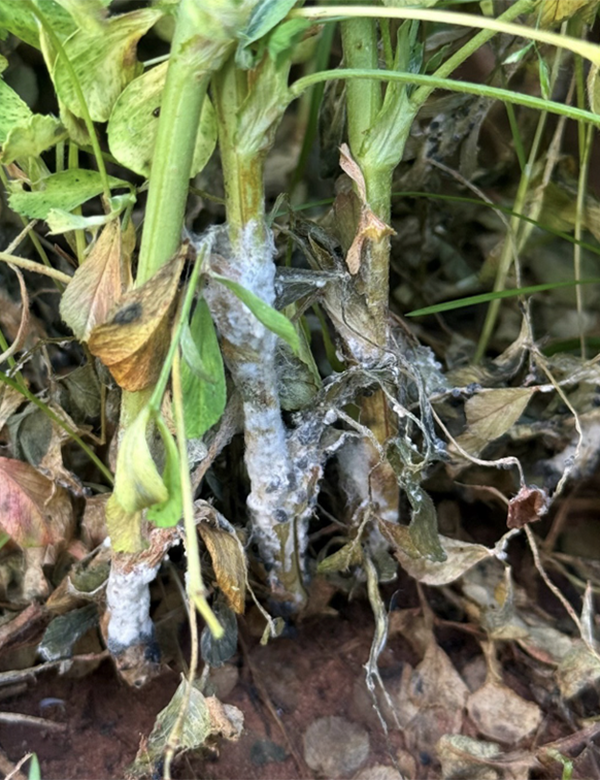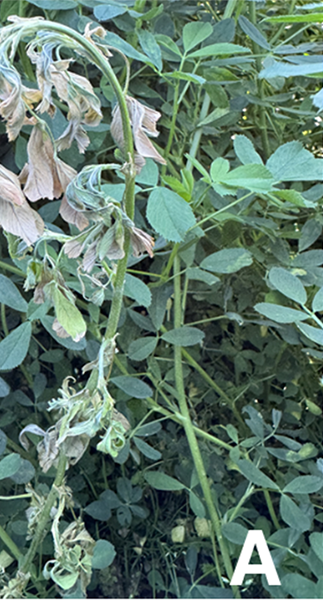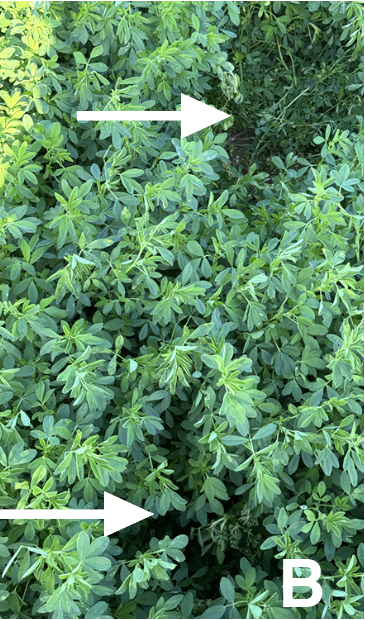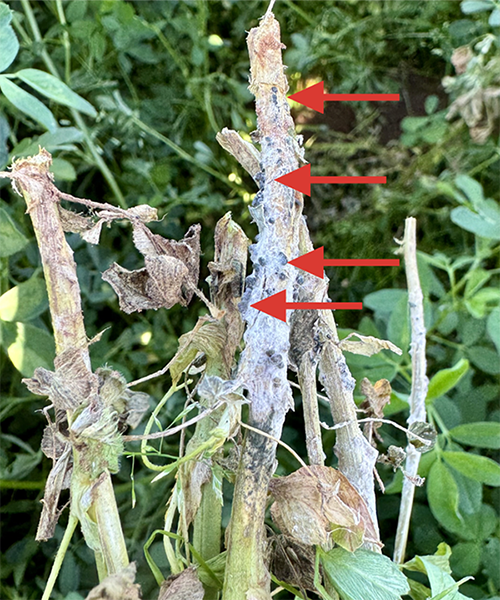Sclerotinia Crown and Stem Rot of Alfalfa
- Jump To:
- Introduction
- Disease Management
Introduction
Sclerotinia crown and stem rot, also called white mold, can be one of the most destructive diseases of alfalfa. The pathogen that causes this disease, Sclerotinia trifoliorum, infects the alfalfa seedlings in the fall after planting under cool and moist conditions. However, symptoms may not become visible in the field until the following spring. Alfalfa fields seeded during spring are less susceptible to infection by the pathogen since stands can develop stronger crowns before the infectious period by the pathogen during fall. In contrast, alfalfa fields seeded in late summer or early fall are most susceptible to the disease. Prolonged snow cover can increase disease severity. In contrast, in dry winters, this disease is not a problem. Limited information is available for this disease in Oklahoma; however, recent reports have confirmed its presence in alfalfa fields, and as environmental conditions change, more cases could develop.
Symptoms:
Symptoms of the disease include the development of profuse, fluffy, white mycelium on the base of the alfalfa stem and diseased alfalfa stems have a bleached, dry appearance (Figure 1). Infected plants become wilted and eventually collapse in the field due to stem and crown rot, which weakens the stem (Fig. 2). The mycelium growing on the plant surface can infect and colonize neighboring plants through direct contact. The fungus also produces black, hard structures known as sclerotia, which are formed when plant nutrients decline (e.g., the plant tissue is already dead) or the environmental conditions become unfavorable (e.g., too hot or too dry for disease development) (Fig. 3). The fungus uses these structures to survive in the soil for many years in the absence of the plant host. Symptoms of this disease can also be mistaken for winterkills. Growers can distinguish between winterkills and Sclerotinia crown and stem rot by scouting the fields and looking at the base of the alfalfa stem of the wilted/dead plants. Plants infected by the disease will show the presence of white mycelia, which may also be associated with sclerotinia production (Fig. 1). Plants affected by winterkill will not have the pathogen structures associated with it. For more information on alfalfa winterkill, please visit: Frost Injury in Alfalfa.
Disease cycle:
The sclerotia of the pathogen over summers in the soil in a dormant stage. In the fall, with adequate soil moisture and decreased soil temperatures (50 – 59 °F), the sclerotia will germinate and produce structures known as apothecia and spores. The apothecia are a small mushroom-like structure, while the spores are considered the seeds of the fungus. The spores of the fungus will be blown to nearby plants, and under wet and cool conditions, the infection process in the alfalfa plants will occur. There is a potential transmission of the pathogen by the sclerotia mixed in with the alfalfa seeds, highlighting that contaminated seeds are a way of disseminating the pathogen over long distances. This is one reason alfalfa growers can experience outbreaks in areas where the disease has not been reported. Alfalfa growers must use clean and certified seeds in their farms to protect their crops from this seed contamination risk.
Disease Management
Planting strategies:
A primary cropping practice for preventing alfalfa crown and stem rot is planting the crop in the spring rather than the or late summer or fall. Warmer temperatures at these times inhibit germination of the sclerotia in the soil, allowing the plant to grow bigger and stronger when the pathogen's spores are released in the fall. However, spring plantings in Oklahoma can be riskier than fall plantings due to dryer conditions, insects, and weed pressure. Planting only sclerotia-free seeds helps to reduce the risk of introducing the pathogen in the area and reduces fungus inoculum in the field.
Crop rotation:
The pathogen that causes Sclerotinia crown and stem rot only infects alfalfa, clover and related forage legumes. The pathogen that causes disease in alfalfa (S. trifoliorum) is not the species that attacks soybean, peanuts, tobacco, canola or vegetable crops. Field crops (e.g., corn, cotton, wheat, sorghum) and annual forage grasses (e.g., Sudangrass) may be used in crop rotation. However, the growers need to keep in mind that the sclerotia of the fungus can survive in the soil for up to 5 to 6 years without any host plant. Once the pathogen is well established in a field and the soil is highly infested with sclerotia, crop rotation may be of less value because of the long survival time of these fungi structures.
Weed control:
The pathogen can remain on volunteer clovers in a pasture indefinitely. Weeds, such as chickweed, further encourage disease by prolonging moist conditions in the canopy. Other weed hosts (e.g., pineappleweed, sowthistle, groundsel, mayweed, mustards, radish, and legumes) can also be the source of new infections. Good weed control reduces the potential survival of the fungi and helps to reduce humidity in the canopy, which favors disease development.
Canopy management:
In fields where the disease had already been reported, strategies to manage Sclero-tinia crown and stem rot include reducing the number of seeds planted per acre to decrease the humidity in the crop canopy. Because infection by spores of the fungus requires an extended period of free moisture, orienting rows parallel to the direction of the prevailing winds may be of some value in drying the canopy more quickly after rain or irrigation events. In addition, general management practices such as identifying a well-drained location for planting and timely harvesting are useful tools for disease management.
Host resistance:
A few current varieties on the market claim moderate Sclerotinia resistance, but results vary by location.
Fungicide applications:
Currently, one fungicide premix, pyraclostrobin/boscalid, is known to reduce the severity of Sclerotinia crown and stem rot disease and increase yield in the first cutting. Mixing two active ingredients with different modes of action (pyraclostrobin and boscalid) is more expensive but provides better disease control and should slow the development of resistant Sclerotinia isolates than using a strobilurin (pyraclostrobin or azoxystrobin) by itself. Please contact your county Extension educator for more information on fungicide applications.
Figure 1. Characteristic symptoms of Sclerotinia crown and stem rot, with the development of profuse, fluffy, white mycelium on the base of the alfalfa stem. Photo courtesy of Maira Duffeck, Oklahoma State University.
Figure 2. Symptoms of alfalfa plants affected by Sclerotinia crown and stem rot. A: Diseased alfalfa stems have a bleached, dry appearance. Infected plants become wilted and eventually collapse in the field due to stem and crown rot, which softens and weakens the stem. B: White arrows represent the wilted plants spotted in the field. Photo courtesy of Maira Duffeck, Oklahoma State University.
Figure 3. Red arrows represent the hard, black structures produced in the mycelium by the fungus Sclerotinia trifoliorum which allow the fungus to survive in the soil for many years in the absence of the plant host. Photo courtesy of Maira Duffeck, Oklahoma State University.




